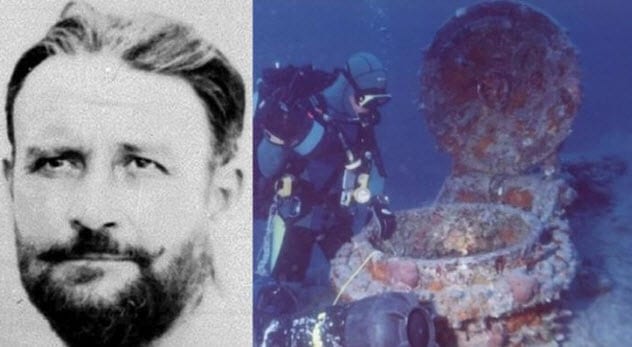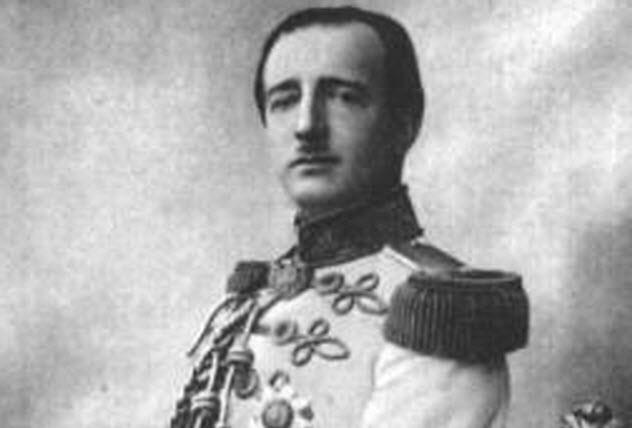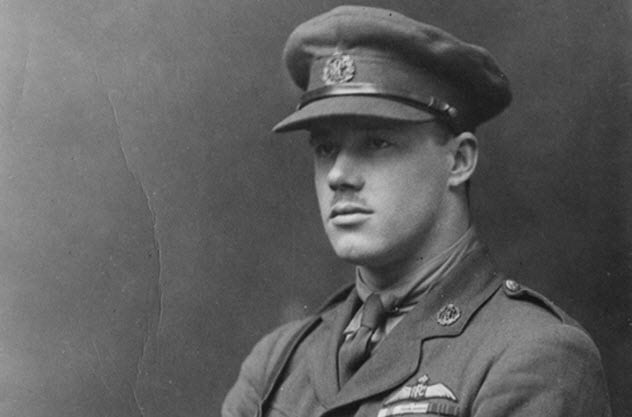 Music
Music  Music
Music  History
History 10 Less Than Jolly Events That Occurred on December 25
 Weird Stuff
Weird Stuff 10 Funny Ways That Researchers Overthink Christmas
 Politics
Politics 10 Political Scandals That Sent Crowds Into the Streets
 Weird Stuff
Weird Stuff Ten Bizarre Facts About The Doge Meme
 Our World
Our World 10 Ways Your Christmas Tree Is More Lit Than You Think
 Movies and TV
Movies and TV The 10 Coolest Stars to Set Sail on The Love Boat
 History
History 10 Things You Didn’t Know About the American National Anthem
 Technology
Technology Top 10 Everyday Tech Buzzwords That Hide a Darker Past
 Humans
Humans 10 Everyday Human Behaviors That Are Actually Survival Instincts
 Music
Music 10 Surprising Origin Stories of Your Favorite Holiday Songs
 History
History 10 Less Than Jolly Events That Occurred on December 25
 Weird Stuff
Weird Stuff 10 Funny Ways That Researchers Overthink Christmas
Who's Behind Listverse?

Jamie Frater
Head Editor
Jamie founded Listverse due to an insatiable desire to share fascinating, obscure, and bizarre facts. He has been a guest speaker on numerous national radio and television stations and is a five time published author.
More About Us Politics
Politics 10 Political Scandals That Sent Crowds Into the Streets
 Weird Stuff
Weird Stuff Ten Bizarre Facts About The Doge Meme
 Our World
Our World 10 Ways Your Christmas Tree Is More Lit Than You Think
 Movies and TV
Movies and TV The 10 Coolest Stars to Set Sail on The Love Boat
 History
History 10 Things You Didn’t Know About the American National Anthem
 Technology
Technology Top 10 Everyday Tech Buzzwords That Hide a Darker Past
 Humans
Humans 10 Everyday Human Behaviors That Are Actually Survival Instincts
10 People From History Who Just Refused To Die
Death is a frightening topic for almost everyone. But no matter what, it comes to all of us in the end. Some people—like those who die in accidents—have no control over how or when their demise will occur. Others—like those with long-term fatal illnesses—have time to decide how to face death.
Still, there are some people who just do not want to go. Despite their ominous circumstances, they survive when others would certainly perish—whether by luck or the sheer will to carry on.
Here are 10 people who refused to go gentle into that good night.
10 The Woman Who Was Hanged (And Then Some)

In 1650, housemaid Anne Greene was seduced by the grandson of her employer and became pregnant. But she told no one. She miscarried six months later and buried the body of her son by herself. When the body was discovered, Greene was charged with infanticide despite clear evidence that the child had been born dead.
Greene was found guilty and sentenced to hang. On December 14, she was “turned off” the scaffold, hanging by the neck for almost half an hour while her friends thumped her on the chest and pulled on her legs with all their might to shorten her ordeal.
Finally, her body was cut from the scaffold and was ordered to be sent to a surgeon for experimental purposes. As she was placed in the coffin, a guard heard Greene breathe. He jumped up and down on her chest a few times to finish her off as an act of charity—or so he said.
Despite this, the surgeon revived Anne Greene with “hot and cold cordials,” throat tickling, and a hot enema. The last one, it seemed, did the trick. Anne Greene was later pardoned, got married, and had three more children before finally dying in childbirth in 1665.[1]
9 The Man Who Fell From His Coffin

In 1571, English farmer Matthew Wall was engaged to be married when he expired suddenly. His friends were carrying his coffin up the steep hill toward the church when one of the pallbearers slipped on wet leaves. The coffin hit the ground with a thud.
In the shocked—and no doubt embarrassed—silence that followed, other thudding sounds could be heard, this time coming from inside the coffin. The sounds were followed by some muffled yelling.
The pallbearers opened the coffin and found Wall alive inside. He had been in a coma, and the jolt of the coffin hitting the ground had brought him back to consciousness.
He went on to marry his fiancee and have two sons. Wall finally died an old man in 1595.
In his will, he bequeathed money to the parish church so that every year, on the anniversary of his first funeral, the church bells would be rung as if for a funeral and then rung again in a wedding peal. He also requested that the lane to the church be swept clear of leaves to ensure that no one else slipped on them.[2]
The tradition is kept to this day. Each year on Old Man’s Day, the children of the village sweep the lane and are rewarded with sweets while the bells ring.
8 The Man Torpedoed Out Of A Submarine

John Capes was a stoker aboard the submarine HMS Perseus when it sailed from Malta to Alexandria in November 1941. On December 6, the submarine was struck by a mine off the coast of Cephalonia.
There were 61 crew members aboard the vessel. Only Capes made it out alive. He claimed that he had been relaxing in a makeshift bunk hidden in a spare torpedo tube when the mine exploded and that he and three others had escaped through a hatch in the engine room. Capes said that he had taken a fortifying tot of rum, helped his comrades into their life preservers, and then made for the surface 52 meters (170 ft) above.
Capes had to swim 8 kilometers (5 mi) to the shore in the cold December sea at night. He headed for the white cliffs of occupied Cephalonia and was found unconscious on the beach by fishermen the next morning. They hid him from the occupying Italian forces for 18 months, moving him from house to house to evade capture.
In 1943, Capes was finally taken off the island. From there, he went to Turkey and then to Alexandria to serve on another submarine. Though he was awarded a British Empire Medal, many people doubted his extraordinary story, particularly as submarine commanders had been ordered to bolt escape hatches from the outside to prevent them from being forced open during depth charge attacks.
Capes died in 1985. But in 1997, his story was finally confirmed. Divers examining the wreck of the Perseus discovered the compartment exactly as he had described it, with the escape hatch unlocked and open and a torpedo tube with a makeshift bunk inside.
They even found his bottle of rum.[3]
7 The Woman Dug Up By Grave Robbers

In 1705, Margorie McCall fell ill and died in Shankill, Ireland. During her wake, there was an undignified row among the mourners over a valuable ring the deceased was wearing. Some of them said they wanted to remove the ring to prevent the body from being dug up by grave robbers. The ring, however, would not budge.
So McCall went to her grave still wearing the ring. Sure enough, that very night, her body was exhumed by robbers. After failing to remove the ring, they produced a knife to cut off the ring finger. As soon as the knife pierced her skin, McCall regained consciousness. The robbers fled, and McCall walked home to her shocked family.
When she finally expired, McCall returned to Shankill Graveyard for a second funeral. You can still see her tombstone which bears the inscription, “Lived Once, Buried Twice.” It is not known whether the ring went with her.[4]
6 The King Who Survived At Least 50 Assassination Attempts

In 1931, King Zog of Albania was shot while leaving the Vienna State Opera House. For most kings, this might be a once-in-a-lifetime thing, but King Zog had already been shot in the early 1920s. That time, he took a few minutes to compose himself and, still bleeding, carried on to the parliament house to make a speech.
Which is impressive. In a way.
King Zog was not entirely beloved by his fellow Albanians. His tendency toward excess when most of his countrymen were dirt-poor did not always go down well. And the monarchy in Albania was relatively young, so he was not widely accepted outside his country. These factors plus his undeniable habit of murdering his political opponents left Zog a marked man.[5]
Zog began to find life difficult. He tried not to be seen in public. He put his family in charge of the army and his mother in charge of tasting his food. However, his paranoia was justified. King Zog is said to have survived at least 50 assassination attempts, including some that occurred after he went into permanent exile in 1939.
He finally died of natural causes in 1961.
5 The Man Who Was Mauled By A Bear

In 1818, Hugh Glass escaped from a pirate crew. He was captured by the Pawnee people and accepted into their tribe. Glass learned how to cross swollen rivers, identify edible plants, start fires, and navigate by the stars. All of this would come in handy.
In 1822, he escaped the tribe and joined a fur hunting expedition led by General Ashley in the northern Missouri River area. There, Glass surprised a female grizzly protecting her cubs. The bear attacked, and Glass was badly mauled. Unable to reach for his gun, he was forced to wrestle the bear with his bare hands.
Convinced that Glass was dying, General Ashley laid him on a bearskin rug and called for volunteers to stay with him until he died. Then they were to bury his body. No one seemed keen on it. But two men stayed after being promised a bonus. They dug Glass’s grave and waited.
After three days, it became clear that the terribly injured Glass was not going to die quickly. So the two men stole Glass’s rifle, knife, and other possessions and left him to die alone. When they caught up with the main party, they gave an account of Glass’s death and burial.
Glass used his survival skills to tend to his wounds. He strapped up his leg, wrapped himself in the bearskin rug, and crawled the 322 kilometers (200 mi) back to civilization.
He maintained that the thought of taking revenge on the two men who had left him for dead gave him the strength to keep going. He spent months crawling to the Cheyenne River, where he built a raft and floated downstream toward help.
Despite his wish for revenge, Hugh Glass didn’t kill the men who had betrayed him. Instead, he reported their treachery to the general and returned to Upper Missouri. There, he had several more adventures before he died in a conflict with the Arikaras tribe in 1833.[6]
4 The Explorer Who Survived Mutiny, Starvation, A Poisoned Arrow, And A Spear

In 1521, Ferdinand Magellan, the first man to sail from the Atlantic Ocean to the Pacific Ocean, was killed while attempting to make the first circumnavigation of the world.
He had left Spain with five ships and 250 men in 1519 and headed for the Spice Islands. He survived an attempted mutiny. Then Magellan lost one of his ships during a reconnaissance mission. And he severely underestimated the size of the Pacific Ocean. The trip that he believed would take a few days took four long months.
Magellan and his crew began to starve. The food ran out, the water turned putrid, and the men contracted scurvy. When they finally hit land on Mactan Island in the Philippines, they were almost dead. In gratitude to God for helping him to successfully find the island, Magellan decided to convert the indigenous population to Christianity. However, he used cannons and muskets rather than hymn books.
Magellan’s cannon fire was ineffective because the coral reef around the island kept the target out of range. So the invaders waded ashore wearing upper body armor. The tribesmen realized that the crew’s legs were unprotected and aimed their arrows lower.
With his men fleeing all around him, Magellan kept on fighting. He was hit by poisoned arrows. Still, he persevered. He was attacked by spears, but he just couldn’t let it go.
Finally, Magellan collapsed into the shallow surf at the ocean’s edge. There, a native slammed a bamboo spear into Magellan’s face. You’d think that would do it. You would be wrong.
Magellan killed the assailant with his lance. The embattled explorer was trying to draw his sword with his injured arm when a dozen natives “all hurled themselves upon him. [ . . . ] They rushed upon him with iron and bamboo spears and with their cutlasses.”
Though Magellan was dead, some of his men continued the circumnavigation attempt, finally completing the trip in 1522. Only 20 of the original 250 crew members made it home.[7]
3 The Comrade With 200 Bullets And An Ice Axe

For Leon Trotsky, assassination was always in the cards. Locked in a bitter feud with Stalin, Trotsky had already survived several attempts on his life when Stalin approved a two-pronged plan to rid himself of his rival in 1939.
The first attempt came in May 1940 when a team of hit men crept up on Trotsky’s hideaway in Mexico and fired over 200 bullets into the house with high-powered weapons. Both Trotsky and his wife survived.
However, a much subtler backup plan was already being prepared. Sylvia Ageloff, an ardent Trotsky supporter and member of his staff, had been targeted several years earlier and introduced to a handsome diplomat named Jacques Mornard. In fact, Mornard was neither a diplomat nor was he named Mornard. He was Ramon Mercader, and he was a Stalinist.
Each day, he dropped Ageloff off at Trotsky’s compound, gradually getting on friendly terms with the guards. When Mercader told them that he had written an article that he would like Trotsky to read, they let him in. Mercader was carrying an ice axe with him.
As soon as Trotsky sat down to read, Mercader hit him with the pick end of the ice axe, penetrating his skull 5 centimeters (2 in) deep. Trotsky managed to scream to attract the attention of the guards and hold Mercader fast until they arrived.
Trotsky finally died the following day, and Mercader was imprisoned for almost 20 years before dying in 1978. His last words were said to be: “I hear it always. I hear the scream. I know he’s waiting for me on the other side.”[8]
2 The Knife Man Who Fell From A Roof, Had TB, Was Stabbed, And Got Bayoneted

Jim Bowie, the designer of the Bowie knife, fought in the Texas Revolution and made his last stand at the Battle of the Alamo. He first cheated death in 1828 when he killed a man in a duel.
It would be fair to call Bowie a hard-living man. He was known to have a sizable drinking problem and almost certainly had yellow fever. In addition, he may have had typhoid, pulmonary tuberculosis, or both. He fell from a roof while drunk, breaking several ribs and leaving him with impaired breathing. He was also bedridden at the beginning of the Battle of the Alamo.
Witnesses stated that they saw enemy soldiers enter Bowie’s sickroom and attack him with bayonets. He was still alive when they carried him into the square where they “tossed him up and caught him on their bayonets.”
Though sick with fever, Bowie fought on. When he was wounded again, he was carried to a bed. From there, he continued to fire his rifle at the enemy until they closed in on him. As they made their final rush, Bowie rose up from his sickbed and stabbed one man in the chest with his eponymous blade and shot another before finally expiring.[9]
1 The Pilot Who Untangled His Plane After A Midair Collision

Keith Caldwell was a fighter pilot on the Western Front during World War I. He was the “highest-scoring” New Zealand air ace with 25 successful missions.
After a failed attempt to enlist at the outbreak of war when he was just 18, Caldwell raised the £100 tuition and entered the New Zealand Flying School. He gained his “ticket” in December 1915 and sailed to England to join the Royal Flying Corp in early 1916. By the time he headed to the front in July 1916, Caldwell had logged only 35 flying hours over both continents.
At age 22, he was promoted to flight commander and was said to be a fearless, aggressive pilot. By the following October, Caldwell had increased his tally of downed aircraft to nine. He was awarded a military cross and was mentioned twice in dispatches.
He was known for his daring feints, including a tail-spin dive during a duel with the German flying ace Werner Voss. Caldwell pulled out of the dive just before the plane was due to hit the ground.[10]
In the final weeks of the war, it seemed as if Caldwell’s luck had run out when he was involved in a midair collision. The impact damaged the plane’s wing struts and sent him spinning downward for several thousand feet. To control the descent, Caldwell crawled onto the lower wing, removed the obstruction, and held the wing strut with one hand while operating the joystick with the other.
Caldwell managed to control the descent enough to be able to crash-land behind British lines. He leaped to safety just seconds before the plane hit the ground. Caldwell survived World War I without a scratch and returned to New Zealand to become a farmer.
He returned to active service during World War II, which he also survived.
Ward Hazell is a writer who travels and an occasional travel writer.
Read about more people who faced death on their own terms on Top 10 Heroic Abductees Who Refused To Die and 10 Awesome Ways People Stared Down Death Through History.








